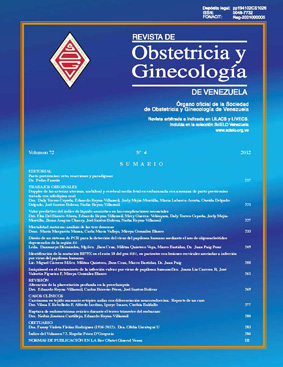Ultrasonido mamario como estudio complementario a la mamografía BI-RADS 0
Palabras clave:
Ecografía Mamaria, Mamografía, BIRADS, Densidad Mamaria, Breast Ultrasound, Mammography, Breast DensityResumen
Analizar la utilidad del ultrasonido mamario como estudio complementario a la mamografía BI-RADS 0. Investigación descriptiva, prospectivo de corte transversal, se realizó ecografía mamaria a 64 pacientes con diagnóstico mamográfico de BI-RADS 0 que acudieron la consulta del Servicio de Ginecología del Hospital General del Este Dr Domingo Luciani, Miranda, Venezuela, durante marzo – agosto 2016. Se describen los hallazgos al ultrasonido. El rango de edad más frecuente fue 41-50 años (40,6 %); entre las razones por la que el BIRADS mamográfico resultó 0 se describen: densidad mamaria (64,1%), nódulo mamario (15,6 %), calcificaciones(7,8 %), densidad asimétrica (6,3 %) y ganglio (6,3 %); dentro de los hallazgos ultrasonográficos se encontraron: sin alteración (37,5 %), quiste simple de mama (23,4 %), probable condición fibroquística de mama (14,1 %), probable fibroadenoma (7,8 %), adenopatía axilar (4,7 %) entre otros; se diagnosticaron 40 lesiones por ultrasonografía, 37 (92,5 %) fueron BI-RADS ecográfico positivo (2, 3 y 4A), y 3 (7,5 %) fueron BI-RADS 0; en los 24 casos BI-RADS 1, no hubo lesión (p=0,001). La ecografía mamaria mostró un 83,1 % de sensibilidad y 97,9 % de especificidad, como método diagnóstico. No hubo relación entre la densidad mamaria y el tamaño de las mamas (p=0,196). La ecografía mamaria resulta útil para mejorar el diagnóstico por imagen de la mama, con alta sensibilidad y especificidad.
To analyze the usefulness of breast ultrasound as a complementary study to the mammography BI-RADS 0. Descriptive, prospective cross-sectional investigation, mammary ultrasound performed on 24 patients with a mammographic diagnosis of BI-RADS 0, who attended the Gynecology Department of the General Hospital del Este Dr Domingo Luciani, Miranda, Venezuela, during March - August 2016 Ultrasound findings are described. The most frequent age range was 41-50 years (40.6%); among the reasons why mammographic BIRADS were 0 described: breast density (64.1%), breast nodule (15.6%), calcifications (7.8%), asymmetric (6.3%) and breast or axillary node (6.3%); Among the ultrasonographic findings were: no alteration (37.5%), simple breast cyst (23.4%), probable fibrocystic breast condition (14.1%), probable fibroadenoma (7.8%), adenopathy axillary (4.7%) among others; 40 lesions were diagnosed by ultrasonography, 37 (92.5%) were BI-RADS positive (2, 3 and 4A), and 3 (7.5%) were BI-RADS 0; In the 24 BI-RADS 1 cases, there was no injury (p = 0.001). Breast ultrasound showed 83.1% sensitivity and 97.9% specificity, as a diagnostic method. There was no relationship between breast density and breast size (p = 0.196). Breast ultrasound is useful to improve the imaging diagnosis of the breast, with high sensitivity and specificity.

